gluing down prefinished SOLID hardwood floors directly over a concrete
Here’s the bottom line – this can be done! 80% of the research I did on this said it can’t be done (including posts on Houzz) or not to attempt it. Well, I’m here to say it can done, here’s how I did it.
1) I applied Bostiks MVP liquid vapor barrier directly to my slab. The slab was clean and porous. You must make sure the slab has no sealer on it. I tested for moisture content and level. I didn’t use a leveler for low spots since the MVP has some leveling properties and I laid the actual wood glue fairly thick. I troweled the MVP on with a v notch 1/8 inch trowel. It took 72 hrs. for the MVP to fully dry.
2) I then used bostiks best glue to lay my prefinished solid maple hardwood flooring. All my products were available from lumber liquidators. The bostiks best went directly onto the MVP; I followed the guidelines for laying the flooring that came with the maple wood. I applied it generously with a v notched quarter inch trowel. I used flooring clamps, 3m 2080 blue tape and waited it down overnight.
I was amazed how strong the floor was after the glue cured. You couldn’t move these boards with a sledgehammer!
Tips: Clean as you go and don’t let glue dry in the grooves. You can’t do this without flooring clamps!! So buy some. Use the 3m 2080 tape and tape the crap out of your floor, you CAN leave it on overnight but don’t put any weight directly on top the tape. Don’t use long boards with a bow, it’s too difficult to straighten them out. Don’t expect it to be perfect there will be small gaps every now and then. Weight the flooring down to ensure proper adhesion to the MVP. Don’t skimp on the bostiks best, I went over board and 5 gallons lasted about 130 square feet.
Hope this is helpful.
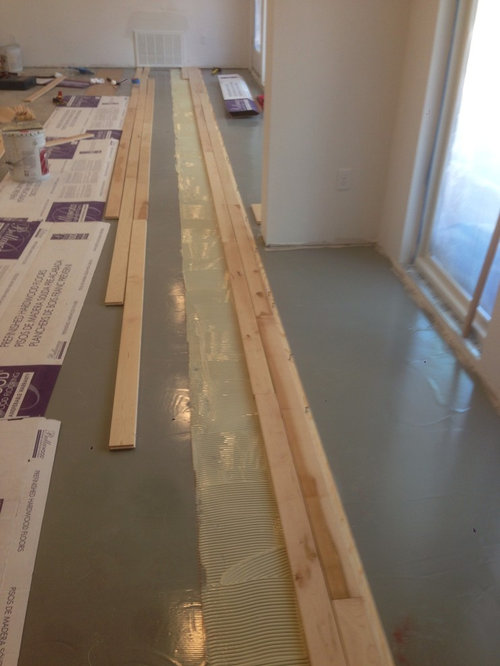
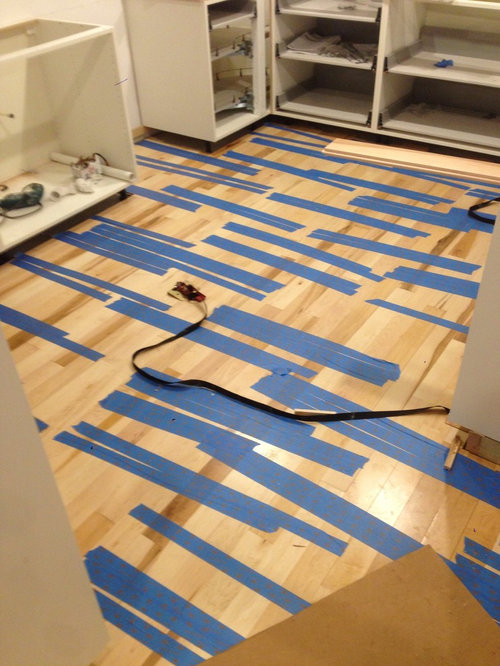
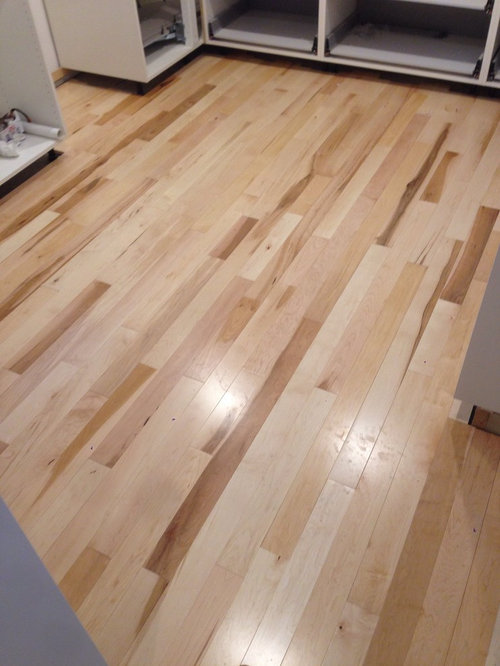
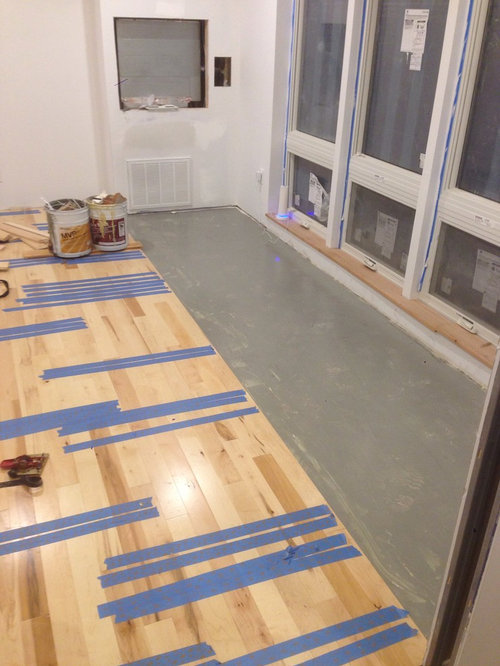
Comments (57)
Al Fortunato Furnituremaker
9 years agolast modified: 9 years agoAs a furniture maker, what about the normal seasonal movement of wood? Wood expands and contracts on a regular basis, thus the reason for all the different methods of joining wood that have been developed over hundreds, oops, thousands of years. If there is no room for it to move, it will split, warp, twist, etc. when it's trying to move. Yea, today's adhesives are very strong so something has to give, the wood maybe, surely not the concrete.
Anything can be done, but done right?
jkeeton72
Original Author9 years agoIf you want to be a critic, go do it somewhere else. As a homeowner, I posted this to be helpful to others but somehow, some people think it's their job to be a critic and naysayer.Al Fortunato Furnituremaker
9 years ago@jkeeton72, you clearly don't understand wood movement and moisture content.
How do you know it was "practically nil"? Did you measure it? How did you measure it? Wood moisture content NEVER reaches "practically nill" in TN. Very dry winters with very humid summers. Wood is typically dried to 6-7% moisture content and will release and absorb moisture with environmental conditions. It is constantly moving across the grain.
Telling others this will work when you haven't experienced years of the installation, is just leading people down the path and potentially creating problems for them. You aren't helping.
I asked if wood movement was taken into account, and explained a little about it, to make others aware of the potential problems. You clearly didn't research this enough!
Good Luck
Select Hardwood Floor Co.
9 years agoAl F. ...Certainly, by now you've figured out that your ideas & viewpoints based on years of experience... are ONLY welcome if they coincide with what the Houzz reader wants to see. You need to join the "cheerleading section" and boost their self esteem.
However, you must also be prepared to dodge the stones which will come your way, being thrown by the Houzzer who feels you didn't adequately prepare them for failure.
Select Hardwood Floor Co.
9 years ago@jkeeton72...
Please keep in mind that YOU enjoy the benefit of total anonymity while doling out advice on Houzz... if some other unsuspecting DIY'er takes your advice and the wheels fall off... your response will be: "hey, it worked for me... you screwed up. Besides that I don't know what I'm doing, I got lucky".
Whereas those of us who operate in the construction materials & services on a professional level don't have that luxury... we have our credentials & business info on display, as well as our reputations to protect.
If we dole out poor advice which leads to problems... we find ourselves up to our elbows in alligators for the effort. The claim would be that the unscrupulous Pro took advantage of the innocent DIY'er who was looking for advice on how to save a few bucks to apply to "the kids college fund, early retirement, gambling addiction, whatever..."
And IMHO perhaps a bit more respect to Mr. Al, who took the time to post his viewpoint on what is still, I believe, considered an "open forum".
Al Fortunato Furnituremaker
9 years ago@ Select, I've been trying to be good and not criticize all the poor advice I read about on Houzz. I've bitten my tongue many times, there is nothing left to bite, so I responded.
Oh Well.
BTW, your post on the sanding dust was great. I hope many Houzzers read it before they experience a real disaster also.Rusty Empire
9 years agoHey guys. I'm still just trying to figure out how to make my own DIY wood filler for our newly laid (raw) Ash flooring! (Sorry I just had to jump in and scavenge for free advice! Pretty opportunistic of me I know) But... back to the original post, I myself appreciate reading this discussion. It has definitely steered me away from installing directly over concrete for another project we have. I had wanted to avoid putting down a subfloor first but can now see that that step is essential when it comes to concrete. Wood is not inert - concrete is. Nuff said.
All the same I wish the jkeeton72 the best and maybe it will work in their situation. But I wouldn't take it to the bank and gamble on my install.River Valley Cabinet Works
9 years agoCan anyone enlighten me on what exactly is "concrete above grade"?
I too will be a "bad, bad boy" and chime in with my man @Al. Wood movement is so powerful that I would bet against your adhesive. I don't know if they still do this, but they used to quarry granite by drilling holes and driving in wood pegs. Then they would soak the pegs with water and the force of the wood expanding would crack the granite.
@jkeeton73-i don't think @Al is being critical.
Legacy Floors
9 years agoLet me also go on record with 17+ years experience installing hardwood flooring- this is a BAD IDEA!!! Solid hardwood should not be glued to a concrete slab. Engineered hardwood is perfectly suited to do the job, and there is no reason to glue down solid hardwood. I have seen some MAJOR disasters because someone who lacked experience did exactly what this post suggests, and ended up with a $16,000 failure in no time.
I equate it to putting a Chevy engine into a Ford. Yes, it "can" be done, but why would you do it? I will always refuse to glue a solid hardwood to a slab. It's not worth the risk.
Additionally, if you used Bostik's, a v-notch trowel isn't near enough adhesive for a 3/4" wood. You'd need a 1/4"x1/4" trowel if you really insisted on doing this. http://www.bostik-us.com/sites/default/files/catalogs/H15_Hardwood_Install_Cat_W.pdf
Again, this is a VERY bad idea, and should not gain traction as a reliable way to install hardwood flooring. The only reason the NWFA is teaching classes on this method is because people insist on doing it regardless of what they are told.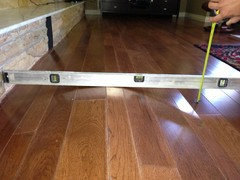
Just my opinion. What shows are photos of someone else's job who decided to glue solid hickory to a slab, and never did RH testing for moisture.
...and it was EVERYWHERE, humps like waves in Lake Michigan.
Please see my Houzz page and for more updates visit
http://www.facebook.com/LegacyFloorsSelect Hardwood Floor Co.
9 years agolast modified: 9 years ago@Legacy Floors...
Once again, evidence that "ya can lead a horse to water..."
And your reference to the NFWA actually "teaching", thus endorsing the idea... is one (of several) reasons I haven't subscribed to membership in years. Another reason is that they began as the NATIONAL Wood Floor Assoc., and should have renamed themselves the MULTI-national Wood Floor Assoc..
User
9 years agoI've personally seen several failures of the fairly common, ''put down a subfloor'' on concrete so to be able to install solid wood flooring. The power of water is an amazing thing to see. And concrete is nothing more than a really hard sponge, wicking that moisture straight through. It can rot that subfloor out in under 5 years when placed on slab with just a piddling piece of poly under it. Or, even a sleeper system can rot the adjacent sole plates if moisture management isn't buit into the installation.
Engineered floors were developed for sound scientific reasons and have been successfully gued to slabs for 40+ years. But, we all know how Americans hate science and reason. And lurve stupid marketers that convince them that ''solid wood'' is the only route to achieving a ''real wood'' floor. Put that nose suitably high in the air, please!
I wanna see pics of he OP's floor this coming summer. I doubt he'll actually follow up and document it though. It's easy to brag on success immediately following glueing hay to a wall. The true test is 5-10 years down the road. Most pros don't design for the next 5 minutes of a TV shoot. They put their names on a project and their reputations at stake. They want happy customers years down the road, giving them referrals. They're in it to produce that 5-10 year result.
Legacy Floors
9 years agolast modified: 9 years agoWell said. From my perspective, the only reason to do this, is to say "I did it".
Select Hardwood Floor Co.
9 years ago@pgcarpet...
Valid points and questions, however the OP doesn't seem inclined to answer any further inquiries in the interest of being "helpful" to the other DIY'ers.
One important point you bring up is the cost factor... typically, the DIY individual is performing the operation to "cut costs", so it never ceases to amaze me when you hear of someone spending 5 bucks to save 2...
Yes, a QUALITY product in an engineered construction would have been a more and economical approach... some of us even offer engineered flooring with as much as a 1/4" top layer... which is the equivalent to the useable material above the tongue in a solid floor.
Oh well... time will tell.
Kingston Flooring LLC
9 years agoI'm not sure why you would want to do this when engineered flooring is perfect for this type of installation. I hope everything works out for you, but someone should have talked you out of this.
kiki D
8 years agoInstalling solid wood Jatoba (Brazilian Cherry) T&G over concrete slab ..... Most info recommends laying ply sub floor but have found a few references to new adhesives & a couple of other ideas that would allow to apply directly over the concrete ..... Any pros out there familiar with these options? Live in Phoenix hence the slab floor. We already have the wood & will be finishing after install.Legacy Floors
8 years agoTo reiterate: In my professional opinion of 17 years, and as a second generation flooring installer- there is NO good reason to install solid wood over a concrete slab. None at all.
Select Hardwood Floor Co.
8 years agolast modified: 8 years ago@kiki D...
Jatoba (solid) + Arizona + glue-down over concrete = problems ahead more than likely. Sorry!
kiki D
8 years agoThanks for the encouragement Sophie .... We've pretty much rebuilt the house from the inside out so I'm sure we'll figure it out ..... Figure there's something to be learned from any opinionCancork Floor Inc.
8 years ago@River Valley Cabs - your poor questions has gotten lost in the mix. I'll help. Ground level = "Grade". Slab ON GRADE = concrete slab that is buried a little into the ground but most is either at or a little above ground (thick concrete). Slab-On-Grade has plenty of the same concerns that a "below" grade slab (AKA a basement) has. In my mind, anything concrete that is "touching dirt" has the potential to "wick moisture" (as Sophie points out) out of the ground and into what ever is touching it. The slabs "below grade" are simply better at it than "slab on grade".
Tecnically "concrete above grade" should be called a "suspended slab" (the type you see in a high-rise building...suspended in the air). I think the wording has been jumbled here and "slab on grade" should have been used instead of "concrete above grade".
"Hard sponge" is an excellent description of concrete. It is porous. It loves to move water through it...it just does it slowly. A 50 year old slab with "very little moisture" at time of testing doesn't mean it will stay that way.
Lets hope for the best.
avacarson07
7 years agoThanks so much for the "how to". We moved into a 20 year old home that a builder built for himself and discovered the original solid wood floors were glued down to a concrete slab. They look amazing to this day but now we want to pull up a bedroom with carpet and install HW but also want to change the color. We were told we would have to put engineered floors on the slab and try to "match" the new finished color, no thanks! Can't wait to finish putting HW on our slab. Your tips are excellent! TY.
RITA K
7 years agoI have a second floor apartment with concrete floors. Will this floor still have the moisture problems on the second floor. Should I consider hardwood or engineered wood flooring?
Legacy Floors
7 years ago@Rita you will need to have a certified or qualified professional perform the Calcium Chloride and In Situ rH tests, as well as pH tests to determine the condition of your slab. Any other avenue and you will be literally gambling on the outcome.
Regarless, engineered wood will be the product vs solid.
Stecki Construction
7 years agoThanks for sharing your information with everyone! Like to hear great ideas! Beautifully done!
Վանեսա Բոուի
6 years agoI have a bunch of reclaimed hardwood flooring and an above grade cement floor. How has it faired two years later?
Dave Ashworth
6 years ago@jkeeton72 I would love to know ~3 years later how the floors look and if you've had any issues with them. I think I scared myself out of doing a similar install (even though the glue down products' tech has improved over the last 17 years to the point where NWFA and the hardwood suppliers approve glue down above grade installations) and will go with engineered hardwood instead, but I'm still curious how you fared.
Shill
6 years agoJust to add something else to the mix. My concrete slab is above grade and is 8 years old. My flooring has been climatised in the house for at least 12 months. We live on the west coast of British Columbia Canada. We would like to install our old growth fir floors directly to the slab. Almost everything I read says don't do it. Do any of these factors way into the equation ?Shill
6 years agoForgot to mention we have radiant heat in the concrete slab. Just another wist in the equation. LolUser
6 years agoComplete disaster in the making. Even very few engineered floors are suitable for use with radiant. And then, ONLY if it’s a low temp loop system with the correct spacing and boiler for an insulative covering. . A standard high temp loop system in slab is only suitable for tile. Otherwise you’re going to wreck your wood, your concrete, and your heating system.
Cancork Floor Inc.
6 years agoIn-floor radiant heat is a special situation. You need to ensure the engineered hardwood you choose is DESIGNED for infloor radiant heat. And then you have to ensure you have adequate humidity control in the home because the wood is going to need very nice humidity because it will dry out quickly when placed so close to a heat source.
User
6 years agoIt doesn't really make sense to put a wood floor over radiant heat as wood is an insulator which would make the system far less effective
Tristen Construction
6 years agoI agree with Sophie and Cancork, with so many precautions to keep in mind I don’t think it would be worth the risk.jared_suzy
5 years agoWe have had glue down solid prefinished teak Bellawood floors throughout most of our downstairs for going on 10 years now. The installers used the method outlined by the OP here. We do have some spacing issues between some boards, but they have been there from the beginning and I think it was more of an installation issue than a moisture issue. Our downstairs bathroom has also flooded twice and it did not damage the floors.
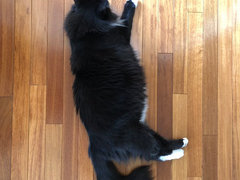
HU-65787451
5 years agoI happened upon this thread because I was looking for a glue reccomendation for a powder bath that had flooded (multiple times) and now the floor has popped from the subfloor. I have some of the old floor in the garage and I was going to throw down 15 sq ft. to replace the lifted boards. I have appx. 900 sq ft of pre-finished solid wood floor glued down, on a concrete slab is still dead flat after 10 years. The installation method was the one intially described and, truth be told, I had 3 installers tell me they would not do it initially. I understand from a business point of view that the risk of a callback isn't worth the install but the installer who did mine was a one man show and very meticulous in his craft. Granted I had to be out of my house for a week but it forced me to take a vacation! Also, in Southern California the humidity doesn't change all that much but then again I'm not sure other parts of the country really build slabs on grade all that much?
Melissa Boutwell
5 years agolast modified: 5 years agoI have a concrete slab floor (at or just above grade) also and had hardwood floors installed using some type of sticky underlayment that allowed the installation. This was done by Home Depot. I had no problems for 4 years until a toilet overflowed due to stuck valve while we were out of the home. Of course the floors then buckled and we had to have a major clean up and dryers put in our home. The floors actually flattened back down after drying but we had them removed anyway. Now my problem is this: I would like to use an engineered floor this time and have done alot of research on them so I know what I like and understand the differences between cheap products and well made ones like Carlisle Wide Plank Flooring, but in my area near Savannah,Georgia there are NO flooring stores who carry anything remotely similar in quality and I am very hesitant to order something that expensive online. Can anyone recommend a similar product sold at least in the south? I am wanting a 3/4" thick white oak at least 6-8" wide and one that comes in lengths longer than the 2-4' lengths these cheap places sell down here and with a wear layer of 4mm. Everything here is 1-2 mm wear layer.
Please help with some suggestions.
ramlahn
5 years agoAny updates on how your floors have held up after a few years? I saw that your project was in 2015. Any moisture / adhesion problems yet?
kiki D
5 years agoFloors still look great. No sign of gaps or other movement issues. Since original post in 2015 - unfinished Jatoba first put down in main area (kitchen, dining & living) applied penetrating oil finish -Penefin- then 2nd coat & hand sanded for smoother finish. Very rustic look & a lot of time/work but feels great on bare feet - wouldn't trade for anything! My husband has put same wood throughout the house. Only exceptions bathrooms tiled - slate in laundry room & entryways. Occasional damp mop - no slopping on water just slightly damp. To be fair house was built in the 70's & we stored the wood in the house for about a month before starting install.J D
3 years agoI installed 3/4 inch oak flooring directly onto a concrete slab 3 years ago.
I used an elastomer glue applied liberally per can directions. It is doing great even tho
I regularly use my switer steam mop to clean it. I suspect that the failures seen are due to incorrect cleaning prior to glueing and using a glue that does not provide the ability for the wood to move a little. The glue i used remasins flexible after 3 years.
looringflooringflofdirectly onJay Cruz
3 years agoTony Montana, couldn’t agree more. Can’t replace good craftsmanship. Bostik MVP4 is even better than just putting a wood subfloor. Wood subfloor is like trying to stop water from coming out of a pipe. With Bostik MVP4 everything is covered. It’s effective like leak protection on faucets. Combine that with Bostik Ultra Single Step 2 and you have an impenetrable floor. I like to learn from Tribal Knowledge but It doesn’t mean I’m not open to challenging the status quo. How can anything evolve or get better without trying something different. This industry has many pros convinced there’s only one reasonable way to do it, and many of those people are also stuck in the Stone Age in other aspects as well.
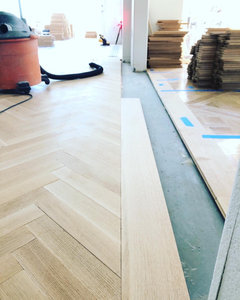
Ray Diaz
3 years ago@jkeeton72 hope your floors are withstanding the test of time. Can you give an update? I actually ordered these exact floors for my condo and need to use gluedown method since i have a concrete slab. Need any reassurance that it will work since ive had several contractors walk away from my project already. Thanks!
Christine Janiuk
3 years agoNice finish! Are you just taping lengths together? I don't get the tape. The idea is to basically make a "scratch coat"? Then adhere the floor to that coat?
Tristen Construction
3 years agoThe tape holds boards together that are trying to pop apart on you until the glue sets up. That’s a difference between glueing and nailing. A nail holds it in place, glue moves. I haven’t read this post in awhile. I wonder what part of the country Tony Montana is in. Humidity/moisture reeks havoc here in Charleston SC. He’s right if the right glue is used and the right material then it will be right.
HU-798897946
2 years agolast modified: 2 years agoIt can be done, I have to agree with Tony. The cut of the wood matters, especially with oak, I installed 3/4 in white oak rift and quartered in my own home 6 yrs ago using Taylor MS. Floors look great still. It's time consuming to install them correctly, but it is well worth the effort. Long length planks can be bought from build direct (10fters) is what I bought. You also have to leave a gap around the walls to allow for any expansion. At least a 1/2" to 3/4". The photo above was from butting floor to wall and with expansion buckeled.
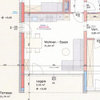
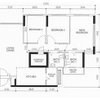
pgcarpet